In relatively shallow ocean waters on the north east coast of Newfoundland Island there are the remains of several ships with the most unusual characteristics. It has been determined that these ships may be the oldest intact ships in the world. We constantly hear of discoveries of the remains of ancient ships and, maybe, because of that, assume that there must be oodles of ancient ships preserved the world over.
Such is not the case. In fact, the number of ships in the 200 – 400-year-old range, in any near-complete state of preservation, can be counted on one’s digits.
The Oldest Known Real Ancient Ships
The oldest known real ancient ships are the Mary Rose (1509), a British warship that was sunk in action in 1545, and the Vasa (1628), a ship that did not make it out of Copenhagen harbor before rolling over.
It seems to be common knowledge in most historical circles now that the Chinese began a campaign, in the late 1300s, to build a large fleet and to attempt to exert its hegemony over the nations of south east Asia. A sub-objective of that initiative was to create a world map. There were so many ships in that enormous fleet that National Geographic Magazine called the great armada, “a massive shadow on the ocean that moved like a floating city that stretched across miles and miles of ocean.” (January 9, 2014). National Geographic also states that the Chinese emperor ordered the fleet to take to the ocean and “to sail to the ends of the earth.”
Indicative of their success, is evidence from recent scholarship that has determined that the Chinese had a world map by 1430 AD, an achievement that could have resulted only from the Chinese fleets visiting virtually every point on earth, including Antarctica.
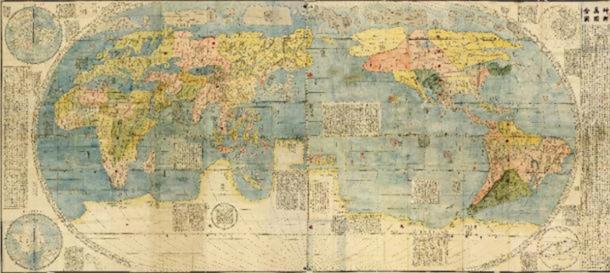
Kunyu Wanguo Quantu. Chinese world map, circa 1430. ( Public Domain )
Grand Admiral Zheng He’s Treasure Voyages
The Grand Admiral of this formidable armada was one Zheng He (variously spelled), a eunuch who was the favorite of the emperor, Zhu De, and who, although having the support and admiration of the palace eunuchs, had only the enmity of the mandarins who feared losing their power and influence. Apparently, around 1430, the mandarins had succeeded in convincing the sitting emperor to cease the “treasure voyages.”
It is not known who actually initiated the voyages. Although Emperor Zhu De gets the credit, the first of the ships were in the water in less than two years after Zhu De assumed the throne, an impossible miracle of construction attributed to the chief administrator, Zheng He, who was subsequently named the admiral of the enormous fleet.
Zheng He gloried in the strength and endurance capacities of his ships on the world’s oceans. Engraved on a tablet at Fujian is a quote attributed to the admiral :
“We have travelled more than 100,000 Li (Approximately 50 000 KM ) of immense water spaces and have witnessed in the ocean waves like mountains, while our sails, unfurled like clouds day and night, continued their course like a star, traversing those savage waves as if we were treading a city street…”
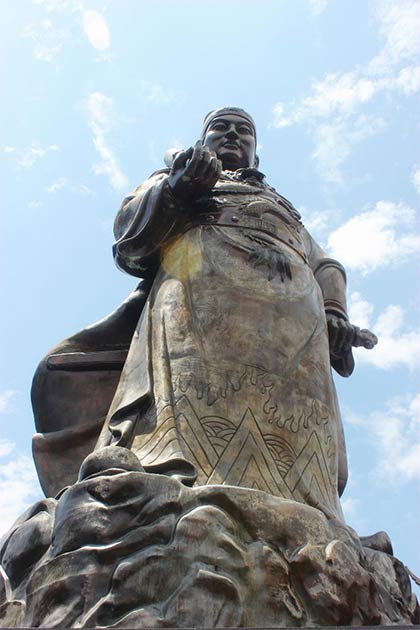
The Statue of Admiral Zheng He in Sam Poo Kong, Semarang city, Indonesia. ( diamirara /Adobe Stock)
Although there is very little sound information about the Chinese effort at hegemony, over the forty or so years from the late 1300s to about 1433, there seems little doubt that the Chinese treasure fleets did make seven or eight voyages from around 1401 to 1435. There is no definitive information to indicate exactly where ALL of the ships went.
It is not even known how many ships of each fleet arrived back in China or, indeed, when. Indeed, some people refer to the ships of these voyages as “Ghost Fleets” because the reliable information about them is so very sparse.
There seems to be little doubt that the Chinese constructed ships of such a size during the first quarter of the 15th Century, that they would not be rivalled for another 450 years.
Our interest here will focus on the voyage of 1433 – 1435.
At least six voyages of the Chinese Treasure Fleet seem to have been conducted successfully, and there are some records for some of the ships. Admiral Zheng He was in charge of at least some of the voyages. Moreover, there is no record in China of what Admiral Zheng He was doing during the 1417 – 1419 voyage.
Indeed, after the sixth voyage, related history is even more fuzzy. The eunuchs and the mandarins were vying for power and for influence. The old emperor, Zhu De, died; the next one died; the third, Xuan De, had acceded to the “Dragon Throne” and was persuaded by the mandarins that further voyages would be to China’s detriment.
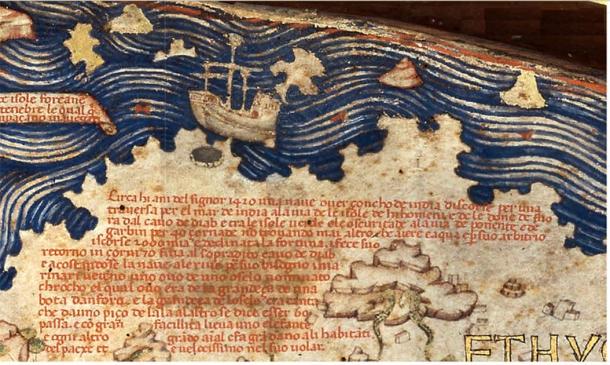
Detail of the Fra Mauro map relating the travels of a junk into the Atlantic Ocean in 1420. The ship also is illustrated above the text. ( Public Domain )
Moreover, it seems clear that the mandarins were fearful of Zheng He and wanted to get rid of this troublesome eunuch. Although Zheng He was a favorite of the first emperor, he was not favored by the second and third. However, the third emperor was reluctant to have Zheng He have a fatal “accident,” and the mandarins were afraid to dispatch Zheng He unless they had a clear understanding from the emperor.
The emperor realized that if Zheng He met with some accident, real or plotted, then the general finger would be pointed at the palace. Even if the emperor held “absolute power,” there were always war lords and other powerful officials ready – and willing – to exploit a judgment lapse. Not willing to risk the wrath of the Chinese people, the emperor appointed Zheng He to some menial administrative job, to get him out of the way. That did not satisfy the mandarins who were beginning to feel their power. They wanted Zheng He out of the picture, completely and permanently.
Besides, in the view of the palace mandarins, Zheng He, a renowned master of military tactics who had been instrumental in placing emperor Zhu De on the throne, was likely at precisely the right place and precisely the right time for him to nurture alliances with those who would be happy to have someone that they could manipulate on the throne. They were concerned at least as much about their heads as they were about their positions of power.
There is, however, no indication that Zheng He entertained any ambition in that direction. Indeed, although still a young man, about 60, apparently, he was ill.
The emperor was cautious. There were literally hundreds of ships out in the bay, riding at anchor. To the Chinese people these ships represented China’s pride. Why were the ships not gone on some important voyage? What is the use of ships, in port, at anchor, slowly rotting, and the reputation and power of the emperor slowly rotting along with them? The ships simply had to go, somewhere. The related optics were crucial!
What to do?

An ancient Chinese ship. ( Мария Тарасова /Adobe Stock)
Go Away and NEVER Come Back!
The emperor recalled Zheng He to Nanjing, the then-capital. What actually happened between the Great Admiral and the emperor is not known. However, it is easy to guess: The emperor told Zheng He to crew all of the ships, to fill the ships, at the emperor’s expense, with everything Zheng He could possibly think of: soldiers, horses, armaments, gunpowder, priests (Muslim, Buddhist, Hindu), specialists of every kind, doctors and other medical personnel, medicines, preserved foods, seeds, root stalks, surveyors, technologists, craftspeople, prostitutes, animals (a veritable Noah’s Ark!), slaves, fine china, silks, and so on.
Then, the emperor had a private conference with Zheng He. The emperor said: “You have everything you could possibly need. You have overseen everything yourself. You cannot blame me if you are missing something. Talk to your officers. Determine whether there is still something you need.”
Then, in a whisper so that none of the listeners could hear – and in the Emperor’s palace there were always listeners: “Take the fleet. Go away. I don’t care where you go. But, wherever you go, do NOT come back! NEVER come back! Do NOT let any of your officers or sailors come back. Nobody, except ….” and he explained the exception. “You have my best wishes. I never want to see you again! Be smart! Go!”
The carved and painted stern of the last ship had hardly disappeared over the horizon before the mandarins began collecting every last scrap of information that they could find about the fleets and about Zheng He. Everything was burned, including ship logs, charts of the voyages, maps, architectural drawings of the various types of ships, ship models, tools, records of construction – in short, everything that they could get their hands on. Apparently, the world map was among the scraps of information that did survive, likely hidden by one of the eunuchs.
The fleet had gone for about a year. Then, one day, a ship, much tattered, arrived back in the harbor. The captain went directly to the emperor. There had been several enormous tempests on the far oceans. Every last ship had been lost, and the grand admiral, himself, the beloved Zheng He, had gone to the bottom with the first tempest near Ceylon. The second tempest had taken the remainder of the fleet near Indonesia.
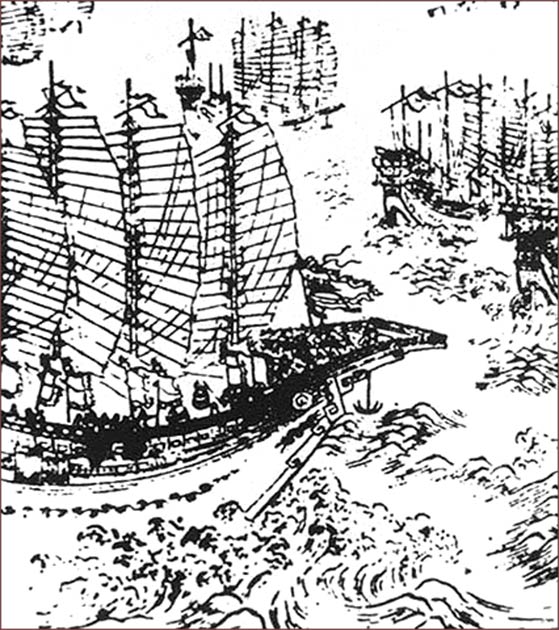
Woodblock print representing Zheng He’s ships. ( Public Domain )
The emperor then announced the sad news to a shocked and mournful nation. He ordered a tomb be built for the beloved Zheng He. In that tomb, they placed one of Zheng He’s robes, a pair of his slippers, and maybe a lock of the revered man’s hair.
What Happened to Zheng He and the Great Fleet?
Nobody knows! What is known is that not a single ship of that fleet, other that one messenger, ever made it back to China. Not a single marine officer, not a single craftsperson, prostitute, or sailor. NOTHING was ever heard from them again. Nothing!
For the most part, the myth of the death of Zheng He in India or Ceylon has been accepted in China as historical fact. There is little room in China for shades of grey, most things being black or white. Zheng He and the great fleet become part of the official national lore. The other aspect of the story, the tempests that took all of the ships, except one, to the bottom of the ocean is, likewise, the official story, it was not to be disputed and not to be questioned, at the peril of one’s head!
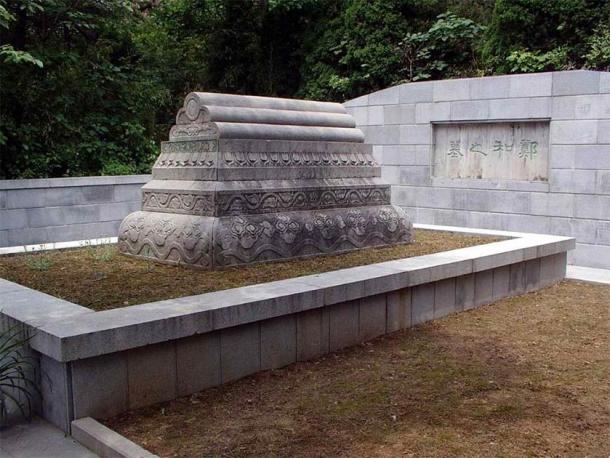
Zheng He’s tomb. Nanjing, China. ( Public Domain )
What Happened to the Ancient Ships?
About 600 years later, two decades ago, China began to resurrect the story of Admiral Zheng He because it was politically convenient to do so, at least according to the detractors of China’s sometimes awkward diplomacy. Besides, the story of Zheng He and the “peaceful” fleets was a source of pride for China, something they could point to as an example of China’s friendly international intentions.
Artifacts of the great fleet of 600 years ago would be of inestimable value to Chinese propaganda. Therefore, China entered into agreements with Sri Lanka, Indonesia, and Kenya to find some of the remains of the great fleet. There just had to be thousands – if not millions – of artifacts, just lying on the bottom of the ocean awaiting retrieval by a grateful nation.
China has spent hundreds of millions of dollars, utilizing the latest underwater technologies of the Chinese navy, in an effort to retrieve the millions of artifacts. Plans for museums in China and other displays worldwide were in the planning stages. China was on the cusp of an enormous diplomatic and publicity coup!
What did they find?
After a decade or so of searching in the waters around Sri Lanka and Indonesia, what did they find?
Nothing!
No ships, no ship remnants, no artifacts, no fine china, no amphora of preserved olives, no skeletons of Chinese sailors. Nothing!
Nothing!
But somehow – without, just now, having a complete narrative to explain it – at some time before recorded history in the annals of Newfoundland Island , the Chinese arrived. They called the island “Island like a Chinese garden” and mapped the whole north western area of the North Atlantic as far as into the Davis Strait and, indeed, according to Chinese sources, Hudson’s Bay. Indeed, the Matteo Ricci Map (Kunyu Universal Map) is a copy of a Chinese map (Kunyu Wanguo Quantu Map) that was completed by 1430, indicating that the voyages of the Chinese fleets from 1405 onward – or at some earlier time – were successful in “mapping the world” and that Zheng He would have had an almost complete map of the world by which to guide his last voyage, some of which – the north west North Atlantic seaboard – Zheng He, himself, had likely mapped during the 1417 – 1419 voyage.
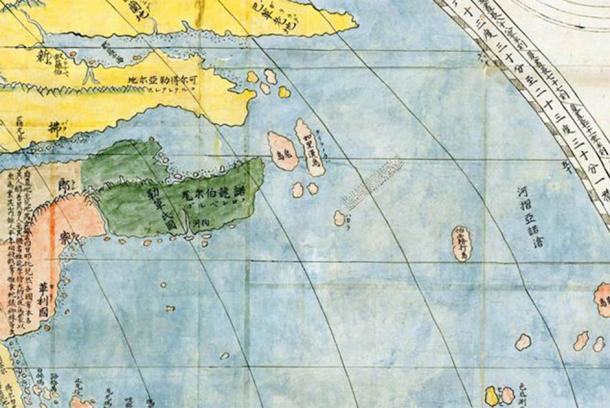
Portion of Kunyu Wanguo Quantu map showing Newfoundland Island. The four ancient Chinese characters on the representation of Newfoundland Island read “Island like a Chinese Garden.’ (Public Domain )
The Ancient Chinese Ships in Newfoundland
At least two of these ships are on the ocean bottom in shallow water in a protected harbor on the rugged north east coast of Newfoundland Island. Other ships have been detected with sonic equipment, including one that appears to be 200 meters (656.17 ft.) long. Moreover, phenomena that has been interpreted as a “graveyard” of ships have been detected in another area of deep, cold water.
The two ships in shallow water have been known about for 350 years or more, from the time of the first European fishermen who arrived in the area and established themselves in what became the dozen or so coastal fishing villages in that area. These ships cannot be European or American. No country, other than China, built ships of this size until well past the mid-1800s. These ships were there before about 1650.
Besides all of that, China has no record of any kind related to the structural aspects of their ships of the Treasure Fleets , no drawings, no models, no descriptions, no images. What China has are the remains of the dockyards that built the ships, some tools, and a rudder that is about 13 – 14 meters (42.65-45.93 ft.) long. Although some marine historians and others have drawn speculative designs of what the ships of the Treasure fleet might have looked like, these drawings do NOT correspond with the ships that have been found in Canadian waters.
The only known intact examples of the Chinese ships associated with the great fleet are resting on the ocean bottom at the north east coast of Newfoundland Island. Nowhere else in the world are there, presently known, unmistakable large ships that might be identified as the ships of the great Chinese Treasure Fleet.
Based on the balance of probabilities, one would be confident in declaring that these ships are from the great Chinese fleet of 1405 – 1435.
To conclude, it seems clear that in the inner ocean waters on the north east coast of Newfoundland Island are the oldest decked ships in existence, and at least some of them are substantially intact.
Top Image: An ancient Chinese ship. Source: Michael Rosskothen / Adobe Stock
By Ronald Lloyd Ryan, DA., PhD.
Views: 0
 RSS Feed
RSS Feed

















 November 1st, 2020
November 1st, 2020  Awake Goy
Awake Goy  Posted in
Posted in  Tags:
Tags: 
















